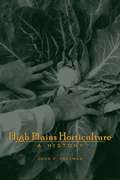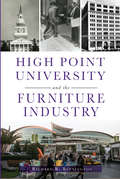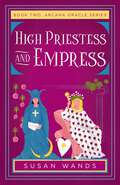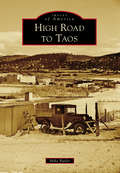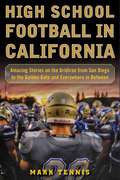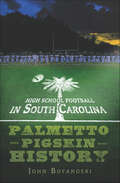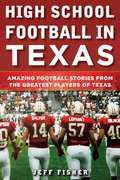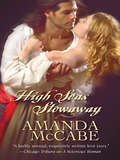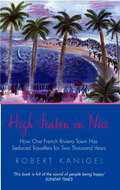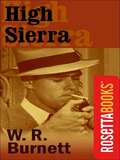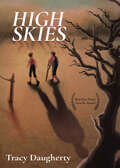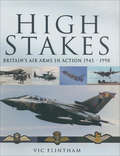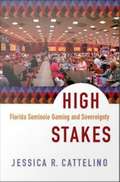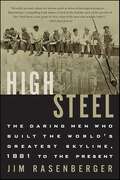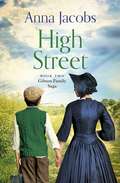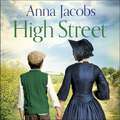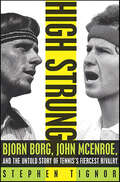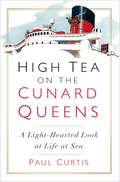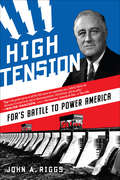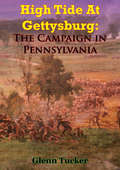- Table View
- List View
High Plains Horticulture: A History
by John F. FreemanHigh Plains Horticulture explores the significant, civilizing role that horticulture has played in the development of farmsteads and rural and urban communities on the High Plains portions of Colorado, Kansas, Nebraska, South Dakota, and Wyoming, drawing on both the science and the application of science practiced since 1840. Freeman explores early efforts to supplement native and imported foodstuffs, state and local encouragement to plant trees, the practice of horticulture at the Union Colony of Greeley, the pioneering activities of economic botanists Charles Bessey (in Nebraska) and Aven Nelson (in Wyoming), and the shift from food production to community beautification as the High Plains were permanently settled and became more urbanized. In approaching the history of horticulture from the perspective of local and unofficial history, Freeman pays tribute to the tempered idealism, learned pragmatism, and perseverance of individuals from all walks of life seeking to create livable places out of the vast, seemingly inhospitable High Plains. He also suggests that, slowly but surely, those that inhabit them have been learning to adjust to the limits of that fragile land. High Plains Horticulture will appeal to not only scientists and professionals but also gardening enthusiasts interested in the history of their hobby on the High Plains.
High Point University and the Furniture Industry
by Richard R. BenningtonHigh Point University was founded in 1924 as a small liberal arts college. The High Point Furniture Market was founded in 1909 and has grown to be the largest wholesale furniture market in the world. Over the past century, the furniture industry and the university have developed an ongoing, mutually beneficial partnership that has resulted in industry-specific programs for students. Discover the history of this relationship and the impact that real-world exposure has had on the students and the industry. Read the stories of several High Point University graduates who are successfully employed in various positions throughout the furniture business. High Point professor Richard Bennington unearths the history of a dynamic partnership.
High Priestess and Empress: Book Two, Arcana Oracle Series
by Susan WandsOn her return to London, artist and seer Pamela Colman Smith discovers that her nemesis, Aleister Crowley, has returned—and his sights are set on her. Despite Aleister&’s efforts to stop Pamela from further developing her tarot deck and accessing its magic, she carries on casting her High Priestess and Empress muses, Golden Dawn society leader Florence Farr and popular theatre star Ellen Terry. But when Ellen is poisoned and nearly killed, Pamela realizes that Aleister won&’t stop coming for her—not until her muses are dead.When Aleister reveals his plot to assassinate Queen Victoria and all female rulers, war breaks out between the Aleister&’s Carlists and the Golden Dawn. With so many lives on the line—that of the queen, and those of her friends—Pamela must access her inner magic to face the battle of her life.
High Rise Stories
by Audrey PettyIn the gripping first-person accounts of High Rise Stories, former residents of Chicago's iconic public housing projects describe life in the now-demolished high-rises. These stories of community, displacement, and poverty in the wake of gentrification give voice to those who have long been ignored, but whose hopes and struggles exist firmly at the heart of our national identity.
High Road to Taos (Images of America)
by Mike ButlerThe High Road to Taos, listed in the New Mexico Register of Cultural Properties in 1975, covers 52 miles from just north of Santa Fe to Ranchos de Taos at the southern boundary of the town of Taos. In addition to spectacular mountain scenery, the High Road contains Pueblo Indian settlements dating back to the 1300s and Hispanic settlements dating back to the 1600s. Historic adobe Catholic churches can be seen in each village, with the church at Las Trampas having been constructed in 1760. Today, artist communities have grown in and around the villages. Photographers from the federal Farm Security Administration extensively photographed the villages along the High Road in the 1930s and 1940s. These photographs provide an exceptional record of Hispanic village life in northern New Mexico and will be of interest to travelers along the High Road as a basis of comparison to what they are viewing today.
High School Football in California: Amazing Stories on the Gridiron from San Diego to the Golden Gate and Everywhere In Between
by Mark TennisFrom the best players to the best coaches and some of the most legendary schools and teams in US history, California high school football has it all. High School Football in California takes an inside look at the state's greatness in the sport, from the best players when they were in high school to those who've gone on to be stars as collegiate players or pros. It's about record-setters, trend-setters, and some of the most inspirational families and people you'll ever meet. Some of the players and coaches featured include Tom Brady, Aaron Rodgers, Bob Ladouceur, Tom Flores, Trent Dilfer, and many more! Extending from the first published report of a game from 1873 to the present, this book presents high school football in a manner never done before. One of the many stories featured recounts how the late Charlie Wedemeyer, former coach at Los Gatos High who suffered from ALS, called plays by having his wife read his lips and then give the plays to assistant coach Butch Cattolico. Cal-Hi Sports editor Mark Tennis mixes amazing anecdotes and interviews with the many who've experienced California high school football from every imaginable angle.
High School Football in South Carolina: Palmetto Pigskin History (Sports)
by John BoyanoskiSouth Carolina has a proud tradition of high school football stretching back to the 1890s, making the sport one of the most celebrated in the state. Discover how Florence High School-- sometimes dubbed the Yellow Jackets or the Golden Tornados--won the first four state titles, a record that has been tied but never broken. And learn about the aftermath of a 1922 game between Columbia and Charleston, when violent Columbia fans hurled eggs at the Charleston train as the players left for home. Through the 1960s, the sport withstood the immense pressure of integration until 157 teams ballooned into 193 by the end of the decade. John Boyanoski reveals the trophies, tears, and triumphs of the Palmetto State's time-honored football legacy.
High School Football in Texas: Amazing Football Stories From the Greatest Players of Texas
by Jeff FisherFrom the best players to the best coaches and some of the most legendary schools and teams in US history, Texas high school football has it all. In the state that made “Friday Night Lights” famous, High School Football in Texas takes an inside look at the state’s greatness in the sport, from the best players when they were in high school to those who’ve gone on to be stars as collegiate players or pros. It’s about record-setters, trend-setters, and some of the most inspirational families and people you’ll ever meet. Some of the players and coaches featured include Mean Joe Greene, Earl Campbell, Andy Dalton, Eric Dickerson, and many more! Covering several generations, this book presents high school football in a manner never done before. Some of the great stories featured recount how future Hall of Famer Drew Brees never got onto the field in his first high school football scrimmage and how Mean Joe Greene wanted to be a running back like Gale Sayers and Jim Brown. High School Football America founder Jeff Fisher mixes amazing anecdotes and interviews with the many who’ve experienced Texas high school football from every imaginable angle.
High School United States History Grade 10
by Prentice-Hall StaffGrade 10 US History Student Edition
High Seas Stowaway
by Amanda MccabePirates, passion and danger on the high seas!Balthazar Grattiano, captain of the infamous shipCalypsoand renowned seducer of women, has just walked into the one tavern in all of Hispanialo he should have avoided. For Bianca Simonetti, his sworn enemy, is the owner--and she has vengeance on her mind. But before she can take her revenge she is captured by this rogue's kiss. Her only chance for retribution is to stow away on his ship for a passionate adventure that will either kill them--or bring them together once and for all!
High Seas to High Society
by Sophia JamesAsher Wellingham, Duke of Carisbrook, was captivated by her! He had happened upon Lady Emma Seaton swimming naked and, beyond her beauty, had seen the deep curling scar on her thigh--a wound that could only be the mark of a sword. Who was this creature of contradictions? Something about her brought back tantalizing memories from the past. Her ill-fitting, threadbare clothes concealed the body of an angel, but what kind of woman truly lay behind her refined mask? Highborn lady or artful courtesan, she intrigued him and Asher wanted to possess both!
High Season In Nice
by Robert KanigelNice is the queen of the Côte d'Azur. Founded by the Greeks some time after the sixth century BC, it has borne the tread of Roman legionnaires and Italy-bound Englishmen on the Grand Tour as well as Lost Generation literati from Hemingway to Fitzgerald. Since the late nineteenth century it has been known as a 'pleasure capital', and now tourism is its beating heart. But how did this happen? What was it that changed not just Nice or the French Riviera, but our leisure habits as a whole?HIGH SEASON is a book about pleasure and escape - about what five months or five days in a strikingly beautiful, foreign place, wrested from lives choked with stress and toil back home, meant to a few wealthy people 250 years ago, and mean to millions more of more modest means today. It is about how modern tourism got the way it did. It is about how Nice and the Riviera became what they are; and about the price they paid to do so.
High Sierra
by W. R. BurnettThe tormented man at the center of W.R. Burnett's High Sierra is a notorious criminal whom the newspapers call "Mad Dog" Roy Earle. Earle is every bit the criminal the newspapers depict, but he is also a complicated soul. Earle, the tragic hero of the novel, is a horribly flawed man, a violent criminal who still retains a conscience. Earle is been moved by the plight of the physically impaired woman named Velma Goodhue, whom he resolves to help, imagining, somehow, that she will be his. After a holdup he plans with Red, Babe, and Marie (who has now fallen in love with him), Earle takes his share of the money to Velma for an operation to repair her clubfoot. But the holdup has disastrous results. Red and Babe are killed, and Roy goes on the lam with Marie. The runaway outlaws have nowhere to turn. Eventually, Velma leaves. Earle sends Marie away to meet him ultimately in a mountain pass in the High Sierras, a rendezvous in the sky in which all that occurs will not take place as envisioned. The plot of High Sierrais remorselessly fast and multithreaded, but Roy Earle trumps our interest. Burnett manage to pain a rich and deeply compelling man without sentimentalizing him. Here is a plot with a tough, bleak, and unforgiving narrative that works a dark magic.
High Skies
by Tracy DaughertyA 1950s Texas small town reels from severe weather, Cold War paranoia, and school integration in this novella by the author of American Originals.High Skies recounts the collision of devastating weather, Cold War suspicion, tense race relations, and the unintended consequences of good intentions in a small west Texas town in the 1950s, changing the futures of the families there and altering their perceptions of America. At the center of this perfect storm is Raymond &“Flyboy&” Seaker, a respected military veteran, now the vice principal of a school in which Troy, who tells the story, and his disabled friend Stevie will have their lives upended forever. Through a combination of his own well-meaning ambitions and the political maneuverings of others, Flyboy, and the families he serves come to grasp the meaning of community and of individual fortitude. Written with a vivid economy recalling Denis Johnson&’s Train Dreams and painting as indelible a portrait of small-town life as Larry McMurtry&’s The Last Picture Show, High Skies is a perfectly distilled American epic.Praise for High Skies &“Tracy Daugherty&’s characters have a stubborn, wonderful realness to them, the sign of a writer absolutely alert to the complex world around us.&” —Andrea Barrett, winner of the National Book Award &“Daugherty&’s writing is deeply rooted in time and place and the historical events that color the characters&’ lives. The effect of this is not nostalgia but a perspective on the relationship between the private and the public, the personal and the political. His characters are wholly realized, the writing as clean as sheets on a summer line.&” —Robert Boswell, PEN West Award finalist &“Daugherty adeptly creates a toxic environment where people&’s fears obscure their rationality and impair their judgment. The account of one man left out to dry makes for a stark, memorable outing.&” —Publishers Weekly
High Society: The Central Role of Mind-Altering Drugs in History, Science, and Culture
by Mike JayAn illustrated cultural history of drug use from its roots in animal intoxication to its future in designer neurochemicals • Featuring artwork from the upcoming High Society exhibition at the Wellcome Collection in London, one of the world’s greatest medical history collections • Explores the roles drugs play in different cultures as medicines, religious sacraments, status symbols, and coveted trade goods • Reveals how drugs drove the global trade and cultural exchange that made the modern world • Examines the causes of drug prohibitions a century ago and the current “war on drugs” Every society is a high society. Every day people drink coffee on European terraces and kava in Pacific villages; chew betel nut in Indonesian markets and coca leaf on Andean mountainsides; swallow ecstasy tablets in the clubs of Amsterdam and opium pills in the deserts of Rajastan; smoke hashish in Himalayan temples and tobacco and marijuana in every nation on earth. Exploring the spectrum of drug use throughout history--from its roots in animal intoxication to its future in designer neurochemicals--High Society paints vivid portraits of the roles drugs play in different cultures as medicines, religious sacraments, status symbols, and coveted trade goods. From the botanicals of the classical world through the mind-bending self-experiments of 18th- and 19th-century scientists to the synthetic molecules that have transformed our understanding of the brain, Mike Jay reveals how drugs such as tobacco, tea, and opium drove the global trade and cultural exchange that created the modern world and examines the forces that led to the prohibition of opium and cocaine a century ago and the “war on drugs” that rages today.
High Stakes: Britain's Air Arms in Action, 1945–1990
by Vic FlinthamAfter the dust of World War II had settled, the military position of the UK was far from straightforward. It was of course allied to the USA and part of NATO, but it was at odds with the former in maintaining an Empire and the two nations also had competing oil interests in the Middle East. The UK's engagement in war after 1945 was thus a strange mixture ranging from homeland security through insular actions within the colonies or protectorates to preserve empire - to playing a major role in confronting the USSR. The types of active involvement of the RAF, Fleet Air Arm and Army Air Corps between 1945 and 1995 include the following, with examples.Maintaining Local Stability - Greece, Netherlands East Indies. Maintaining Empire - Malaya, Kenya. Defending Empire - Borneo. Defending Interests - Suez, Kuwait. Homeland Security - Northern Ireland, air defence. Confrontation - Berlin Airlift, Korea. Covert Action - Albania, strategic reconnaissance. Humanitarian and Peacekeeping- Jordan, Cyprus. Development of Deterrent - Bombs, bombers and missiles.
High Stakes: Florida Seminole Gaming and Sovereignty
by Jessica R. CattelinoIn 1979, Florida Seminoles opened the first tribally operated high-stakes bingo hall in North America. At the time, their annual budget stood at less than $2 million. By 2006, net income from gaming had surpassed $600 million. This dramatic shift from poverty to relative economic security has created tangible benefits for tribal citizens, including employment, universal health insurance, and social services. Renewed political self-governance and economic strength have reversed decades of U. S. settler-state control. At the same time, gaming has brought new dilemmas to reservation communities and triggered outside accusations that Seminoles are sacrificing their culture by embracing capitalism. In High Stakes, Jessica R. Cattelino tells the story of Seminoles' complex efforts to maintain politically and culturally distinct values in a time of new prosperity. Cattelino presents a vivid ethnographic account of the history and consequences of Seminole gaming. Drawing on research conducted with tribal permission, she describes casino operations, chronicles the everyday life and history of the Seminole Tribe, and shares the insights of individual Seminoles. At the same time, she unravels the complex connections among cultural difference, economic power, and political rights. Through analyses of Seminole housing, museum and language programs, legal disputes, and everyday activities, she shows how Seminoles use gaming revenue to enact their sovereignty. They do so in part, she argues, through relations of interdependency with others. High Stakes compels rethinking of the conditions of indigeneity, the power of money, and the meaning of sovereignty.
High Steel: The Daring Men Who Built the World's Greatest Skyline, 1881 to the Present
by Jim RasenbergerA powerful first-hand account of the many generations and ethnic groups of men who have built America's skyscrapers.From the early days of steel construction in Chicago, through the great boom years of New York city ironwork, and up through the present, High Steel follows the trajectory of careers inextricably linked to both great accomplishment and catastrophic disaster. The personal stories reveal the lives of ironworkers and the dangers they face as they walk across the windswept, swaying summits of tomorrow's skyscrapers, balanced on steel girders sometimes only six inches wide. Rasenberger explores both the greatest accomplishments of ironwork—the vaulting bridges and towers that define America's skyline—and the deadliest disasters, such as the Quebec Bridge Collapse of 1907, when 75 ironworkers, including 33 Mohawk Indians, fell to their deaths. High Steel is an accessible, thrilling, and vertiginous portrait of the lives of some of our most brave yet unrecognized men.
High Street: Book Two in the gripping, uplifting Gibson Family Saga
by Anna Jacobs**Book two in the gorgeously heartwarming Gibson Family series, perfect for fans of Catherine Cookson, Dilly Court and 'Call the Midwife'**Lancashire, 1845. Annie Gibson can finally leave Salem Street. At long last she's realised her dream of opening an elegant dressmaking salon in the mill town of Bilsden - and she is determined to take her father and his second family with her, away from poverty. But Annie's troubles are far from over. Someone is trying to undermine her business; her family have their own ideas about what they want to do with their lives; and several men are persistently trying to win her favour, including Frederick, the mill owner, and Daniel, her childhood friend.As Annie gets better acquainted with both, she becomes increasingly confused about her feelings. Can she really be in love? And can she risk trusting any man ever again?**************Praise for Anna Jacobs: 'Catherine Cookson fans will cheer!' - Peterborough Evening Telegraph'Anna Jacobs' books are deservedly popular. She is one of the best writers of Lancashire sagas around' - Historical Novels Reviews'Anna Jacobs' books have an impressive grasp of human emotions' - Sunday Times
High Street: Book Two in the gripping, uplifting Gibson Family Saga (Gibson Saga #2)
by Anna Jacobs**Book two in the gorgeously heartwarming Gibson Family series, perfect for fans of Catherine Cookson, Dilly Court and 'Call the Midwife'**Lancashire, 1845. Annie Gibson can finally leave Salem Street. At long last she's realised her dream of opening an elegant dressmaking salon in the mill town of Bilsden - and she is determined to take her father and his second family with her, away from poverty. But Annie's troubles are far from over. Someone is trying to undermine her business; her family have their own ideas about what they want to do with their lives; and several men are persistently trying to win her favour, including Frederick, the mill owner, and Daniel, her childhood friend.As Annie gets better acquainted with both, she becomes increasingly confused about her feelings. Can she really be in love? And can she risk trusting any man ever again?**************Praise for Anna Jacobs: 'Catherine Cookson fans will cheer!' - Peterborough Evening Telegraph'Anna Jacobs' books are deservedly popular. She is one of the best writers of Lancashire sagas around' - Historical Novels Reviews'Anna Jacobs' books have an impressive grasp of human emotions' - Sunday Times
High Street: Book Two in the gripping, uplifting Gibson Family Saga (Gibson Saga #2)
by Anna JacobsThe second in the heartwarming Lancashire saga series that began with SALEM STREET, by beloved author Anna Jacobs.In 1845 Annie Gibson can finally leave Salem Street. Her dreams of being able to open an elegant dressmaking salon in the High Street of Bilsden, a Lancashire mill town, have come true. And she is going to take her father and his second family with her, away from poverty, away from the Rows.But Annie has not left trouble behind. Someone is trying to undermine her business. Her family have their own ideas about what they want to do with their lives. And several men are persistently trying to win favour with the beautiful young widow - including Frederick Hallam, the mill owner, and Daniel O'Connor, her childhood friend.As Annie gets better acquainted with both, she becomes increasingly confused about her feelings. Can she really be in love And can she risk trusting any man again. (P) 2021 Hodder & Stoughton Ltd
High Strung: Bjorn Borg, John McEnroe, and the Untold Story of Tennis's Fiercest Rivalry
by Stephen Tignor“A book full of aces....A true page-turner.”—Associated Press“This is good stuff, and it’s written with flair.”—The OregonianHigh Strung by Stephen Tignor is the gripping untold story of the fiercest rivalry in the history of professional tennis. Viewed through the lens of the fabled 1981 U.S. Open match between Bjorn Borg and John McEnroe, High Strung brings the golden age of tennis vibrantly alive once more. A fascinating chronicle that orbits around the four greatest, most enigmatic talents in the sport at the time—McEnroe, Borg, Jimmy Connors, and Vitas Gerulaitis—High Strung is a superior sports history, a must read for anyone who truly loves the game.
High Tea on the Cunard Queens: A Light-Hearted Look at Life at Sea
by Paul CurtisThis amusing insight into Cunard’s legendary liners begins more than fifty years ago when the author joined the original Queen Mary as an entertainments officer, when a part of the job was ‘bumbling’ the passengers while keeping a wary eye out for professional gamblers criss-crossing the Atlantic, and there was bingo and dance bands, novelty dancing and fancy-dress parades, and a primitive disco with a monster juke box. Paul Curtis recounts the stories of the ships, the antics of passengers and crews, and much more besides. Just turning these pages releases a sniff of the sea and a whiff of champagne. This frank and funny account of mixes Cunard history with personal anecdote and vividly reveals how passenger and crew life have changed over the years across the Cunard liners.
High Tension: FDR's Battle to Power America
by John A. RiggsAn account of Franklin Roosevelt&’s battle against the power industry to bring electricity to rural communities in the United States. When Franklin Delano Roosevelt took office in the depths of the Depression, high tension―or high voltage―power lines had been marching across the country for decades, delivering urban Americans a parade of life-transforming inventions from electric lights and radios to refrigerators and washing machines. But most rural Americans still lived in the punishing pre-electric era, unconnected to the grid, their lives consumed and bodies broken by backbreaking chores.High Tension is the story of FDR&’s battle against the &“Power Trust,&” an elaborate Wall Street-controlled web of holding companies, to electrify all of America―even when the corrupt captains of the industry and their cronies (led by a formidable and honest champion, Wendell Willkie, whose role in the battle propelled him to a presidential bid to unseat Roosevelt in 1940) cried that running lines to rural areas would not be profitable and that in a free market there would simply have to be a divide between the electricity haves and have-nots. Roosevelt knew better. And in this story of shrewd political maneuvering, controversial legislation, New Deal government organizations like the Tennessee Valley Authority, the packing of Federal courts, towering business figures, greedy villains, and the crying needs of farmers and other rural citizens desperate for services critical to their daily lives, John A. Riggs has chronicled democracy&’s greatest balancing act of government intervention with private market forces. Here is the tale of how FDR&’s efforts brought affordable electricity to all Americans, powered the industrial might that won World War II, and established a model for public-private solutions today in areas such as transportation infrastructure, broadband, and health care.Praise for High Tension &“The little known but captivating story of electricity is at the heart of the New Deal. John A. Riggs is the perfect person to tell the tale.&” ―Walter Isaacson, author of The Innovators, Leonardo da Vinci, and Steve Jobs &“[A] lucid and compelling tale. This is a fresh angle of vision on one of the most important and under-appreciated stories of the first half of the 20th century.&” ―Jonathan Alter, author of The Defining Moment: FDR&’s Hundred Days and the Triumph of Hope &“An innovative history of the chaos and conniving that created America&’s transformative electricity system. . . . A compelling read. Thoroughly researched and gracefully written. . . . A must for historians, it is also a gripping read for all.&” ―Martin J. Sherwin, Pulitzer Prize-winning co-author of American Prometheus: The Triumph and Tragedy of J. Robert Oppenheimer &“[A]n exhaustive look at President Franklin Roosevelt&’s multipronged war against the private utility sector. . . . Riggs dives deep into the legislative, judicial, and public opinion battles over Roosevelt&’s energy initiatives, including the Tennessee Valley Authority, and argues that the hybrid public-private system that emerged in America was critical to the nation&’s &“economic global supremacy&” during and after WWII. . . . [T]his authoritative account is a valuable resource for students of America&’s energy policy.&” ―Publishers Weekly
High Tide At Gettysburg: The Campaign In Pennsylvania
by Glenn Tucker""Gettysburg had everything," Henry S. Commager recently wrote. "It was the greatest battle ever fought on our continent; it boasts more heroic chapters than any other one battle. It was the high tide of the Confederacy."This is the way Glenn Tucker has always seen it and this is the way he reports it in High Tide at Gettysburg. The story of Gettysburg has never been told better, perhaps never so well as in this volume. Glenn Tucker has the immediacy of a war correspondent on the spot along with the insights that come from painstaking research. The armies live again in his pages.In his big, generous book Glenn Tucker has room to follow Lee's army up from Chancellorsville across Maryland into Pennsylvania. With Jackson recently killed, Lee had revamped his top command.When Meade's men caught up with the Confederates and the two armies were probing to locate each other's concentrations, Mr. Tucker's account becomes sharper, more dramatic. His rapidly moving, vivid narrative of the three-day battle is filled with fascinating episodes and fresh, stimulating appraisals.Glenn Tucker is akin to Ernie Pyle in his interest in people. With him you meet Harry King Burgwyn, "boy colonel" of the 26th North Carolina, just turned twenty-one, who slugged it out with Col. Henry A. Morrow of the 24th Michigan until few survived on either side. You feel the patriotic surge of white-haired William Barksdale, who led his Mississippians on the "grandest charge of the war" and died as he broke the Federal line. You sense the magnetism of Hancock the Superb, and feel the driving power of rugged Uncle John Sedgwick as he hurried his big VI Corps to the battlefield. With Old Man Greene you struggle in the darkness to save the Culp's Hill trenches. And much more. Mr. Tucker weaves in many sharp thumbnail biographical sketches without slowing the action. Many North Carolinians, previously slighted, here receive their due.Full, dramatic, immediate, here is Gettysburg."
